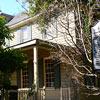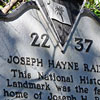Joseph H. Rainey House
Located at 909 Prince Street in Georgetown, the Joseph H. Rainey House was the home of the first African American to serve in the U.S. House of Representatives. This house is listed on the National Register of Historic Places.
Photo Gallery
Click icon to enlarge image. Use arrow keys or
click large picture to cycle through the gallery.
|
Joseph H. Rainey House
Itinerary
Add This Site to Your Itinerary
Site Description
Joseph Hayne Rainey, a Republican congressman from South Carolina, was the first African American to serve in the United States House of Representatives. He was born to slave parents, Edward L. and Gracie Rainey, on June 21, 1832, and according to local tradition he was born in this house on Prince Street in Georgetown. His father, who was a barber, purchased his family's freedom. In 1846, the Rainey family moved to Charleston, where Edward Rainey practiced his barber trade and became prosperous enough to own two slaves.
Access and Admission
Joseph Rainey received a limited education and took up his father's trade of barbering, becoming a successful African-American freedman in Charleston. In 1859, he traveled to Philadelphia, where he married a mulatto woman named Susan who was born of French-African descent in the West Indies. He brought her to Charleston where he became a barber at the city's prestigious Mills House Hotel. Eventually, the couple had three children. During the Civil War, Josephy Rainey reportedly served for a time as a steward aboard one of the many blockade runners that defied the Federal naval blockade of the South Carolina Coast. In 1862, when he and other Charleston freedmen were drafted by the state to build Confederate fortifications, he and his wife fled to Bermuda aboard a blockade runner. In St. George and Hamilton, Bermuda, he resumed the barber trade and his wife was employed as a seamstress. Today, Barber's Alley, a prominent landmark in Hamilton, Bermuda, is named for Rainey's barber shop. After the Civil War, and with a measure of wealth from his successful barber practice in Bermuda, Rainey returned to the family home in Georgetown. There, during the Reconstruction Era, he began a political career as a South Carolina Republican. He was a delegate to the state Constitutional Convention in 1868, where he advocated the establishment of a poll tax with revenues donated to public education. In 1870, he was elected to the state Senate, became chairman of the Senate Finance Committee, and also served as a brigadier general in the South Carolina militia. In December of 1870, South Carolina's Republican Party selected Rainey to fill the unexpired term of Benjamin Franklin Whittemore, a Northern-born, white, Republican congressman from South Carolina who had resigned his seat while under investigation for selling appointments to West Point. Joseph H. Rainey, thus became the first African American to serve in the United States House of Representatives. He was reelected four additional times to South Carolina's First District Congressional Seat, serving from 1870 to 1879. In Congress, he worked to expand civil rights for black Americans, Native Americans and Asian immigrants, and he also attempted to fairly represent his district's white residents, supporting amnesty for former Confederate soldiers. In 1878, he was defeated for reelection by a white Democrat, John S. Richardson. Republican friends in Congress secured him an appointment as an Internal Revenue agent in South Carolina. Later, he returned to business, investing in the Columbia-Greenville Railroad, directing a black-owned freight service in Charleston, and engaging in a banking and brokerage firm in Washington, D.C. His health deteriorated, however, and he retired to the family home on Prince Street in Georgetown in 1887. He died of "congestive fever" in this house on August 2, 1887. He was buried in Georgetown's Baptist Cemetery, although the location of his grave is unknown today. The Joseph H. Rainey House is believed to have been constructed in the Colonial Era, and it retains many 19th century features from the period in which it was occupied by the Rainey family. It is a two-and-a-half story, clapboard, frame house which has much of its original interior woodwork and fireplaces. The home is a National Historic Landmark. Nearby, the Georgetown Rice Museum contains an extensive exhibit on Congressman Rainey and his Georgetown connection. Historic Registry: National Register of Historic Places
|

